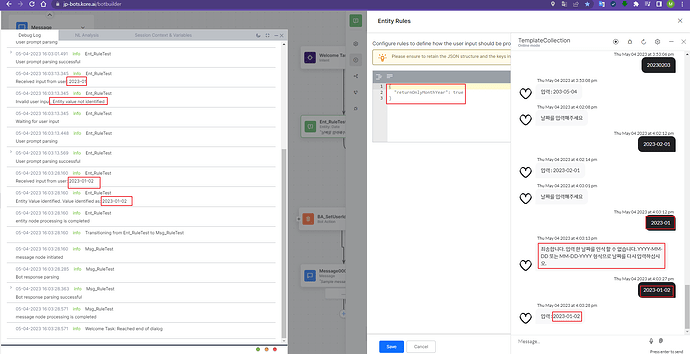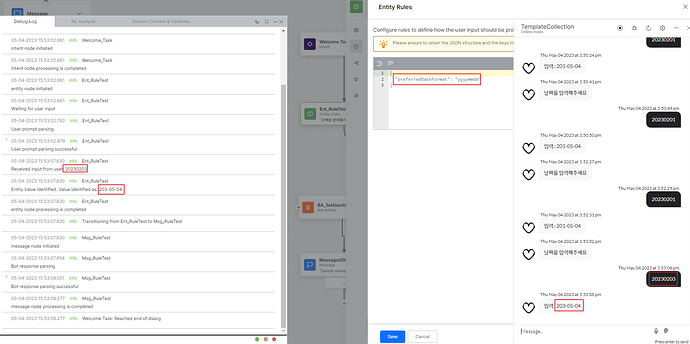I found. There is an Entitiy type that receives the year, month, and date, but there is no type that receives the year, month, and date, so I’m worried.
In the case of the year, month and day, it is also implemented as a date picker, but in the case of the month, it is not visible.
I want to know if there is any good solution.
See Entity Rules, https://developer.kore.ai/docs/bots/how-tos/entity-rules/#Date_type_entity
A “rule” can be set on a Date entity to return only a month and year as the entity value.
First of all, thank you for your answer.
I read the doc and tried applying the rule.
But it doesn’t work. I wondered if I was doing something wrong, so I watched the video of the academy, but the application method seemed the same.
Let me explain how I did it. Please let me know if there are any mistakes or things I need to change.
-
Specify the year and month
According to the doc description, it says that it will not ask again if you do not enter a day, but it keeps asking again.
-
Specify the date format
When 20130203
What I want is 2013-02-03
203-05-04 Kana is coming.
This value is not what I want.
-
Set multiple rules
Should I put the two in one {}?
I wonder if I need to do each {} separately.
Also, there was no answer to the monthpicker in the web-sdk datepicker, but if you know this part, please answer.
Thanks
Ah, it looks like there is a problem in the Japanese language parsing of the dates because I’ve just rechecked this rule and it is working in English.
For your 3rd question, if you want to apply several rules to an entity then they need to be inside one object
{
"rule1" : "...",
"rule2" : "..."
}
There are also additional questions.
In the case of “preferredDateFormat”, there may be times when you want to add several
How do I enter multiple ?
Here’s what I thought.
- Dividing based on ,
{
“preferredDateFormat”: “mm-dd-yyyy, yyyymmdd”
}
- Splitting into arrays inside
{
“preferredDateFormat”:[ “mm-dd-yyyy”, “yyyymmdd”]
}
First of all, thank you for your response.
Can I get an update on when this issue will be fixed?
And I’m using a jp server, but the language I’m working with is Korean.
Thanks
Yes, sorry, I can see it is Korean now, my mistake.
I need to let some-one else chime in with an update on the date processing.
The purpose of the preferredDate entity rule is just to define the basic order of the date components if and when a date is ambiguous - i.e. how to interpret 01-02-03. The actual format is not important, it is just the order of D, M and Y that is significant.
Typically this is only relevant for English because those native speakers in different countries use different formats. Most other languages have a standard date component order where it would be incorrect to use anything but that standard.
The rule does NOT stipulate how users can or should enter dates. The date entity is very flexible in parsing dates and (in theory) can handle any format.

